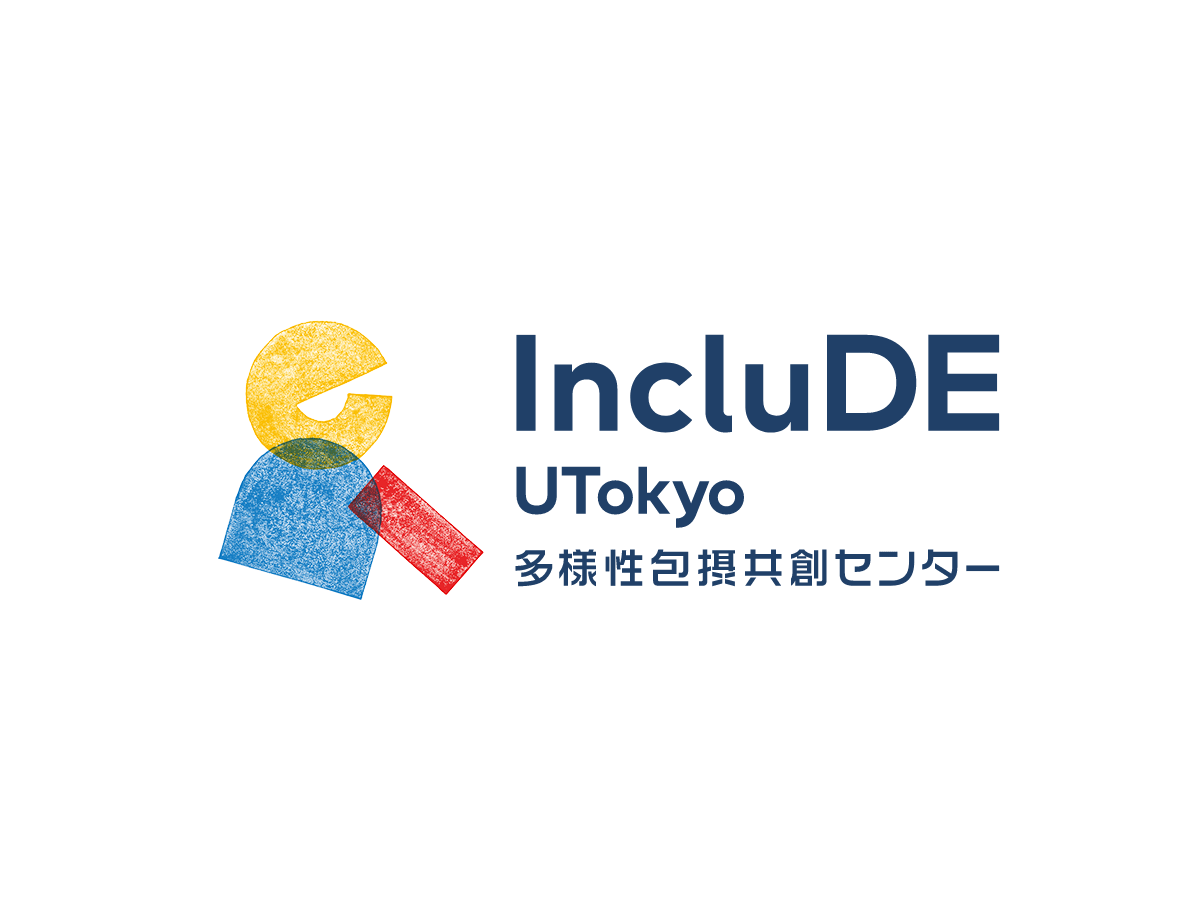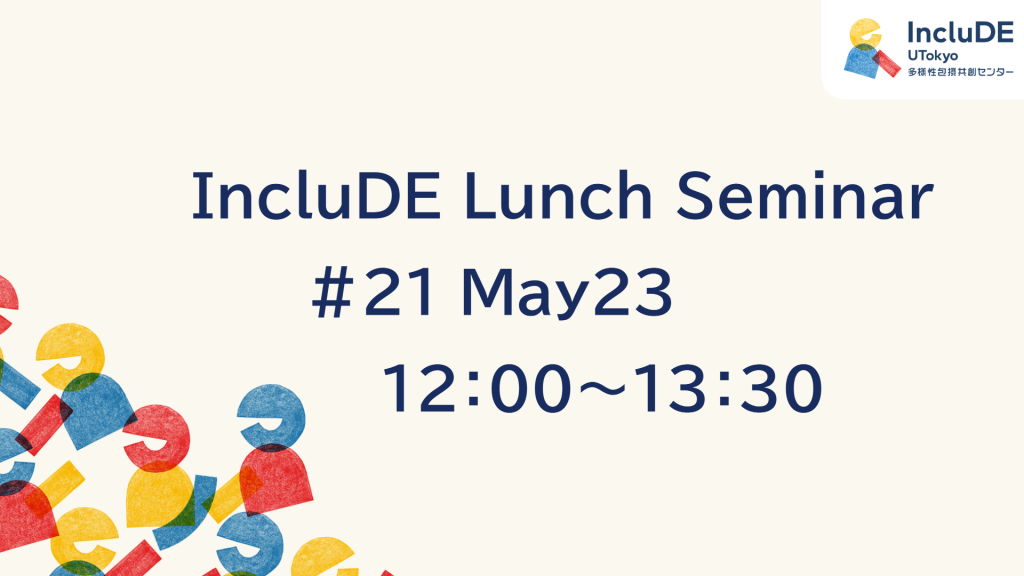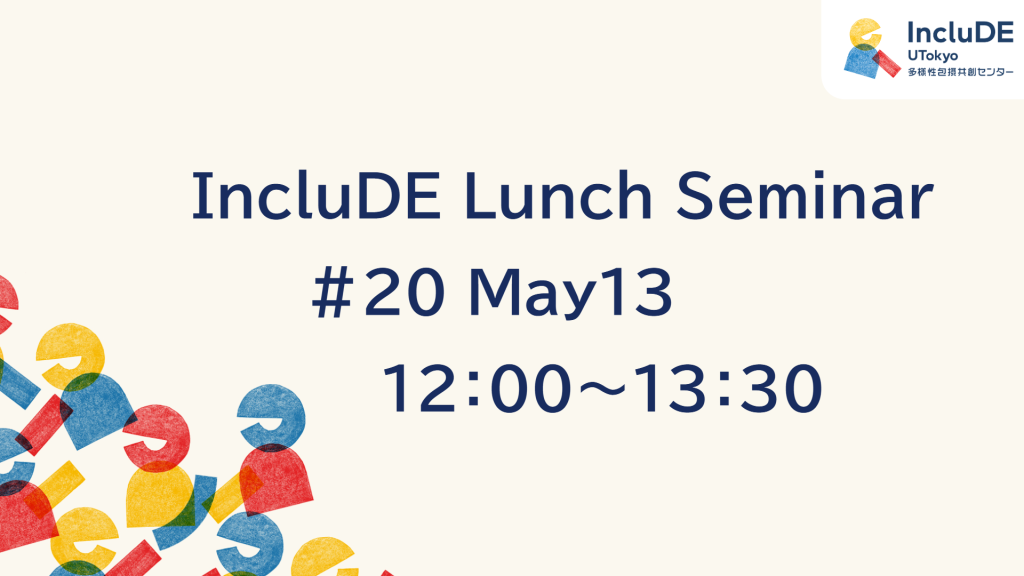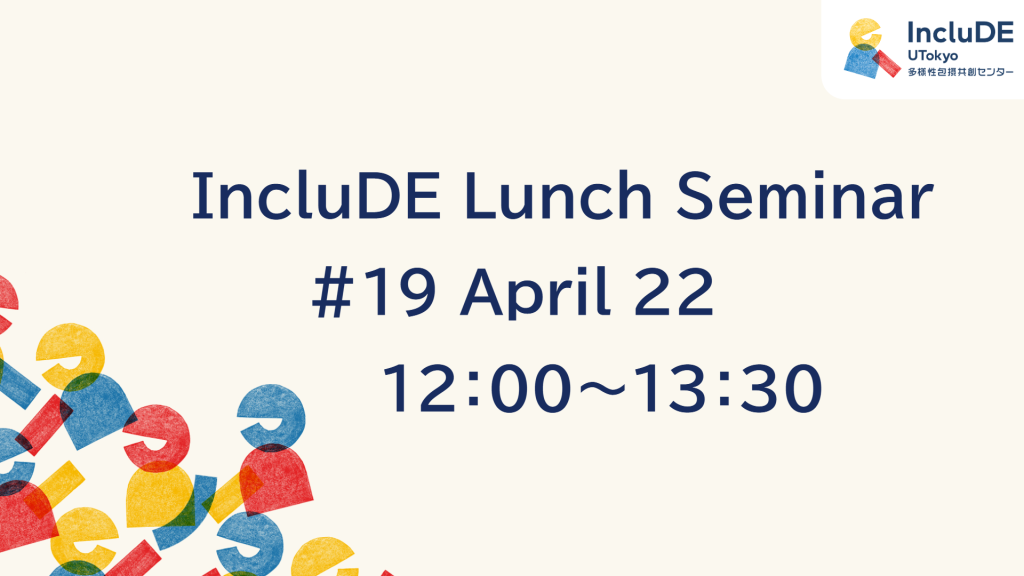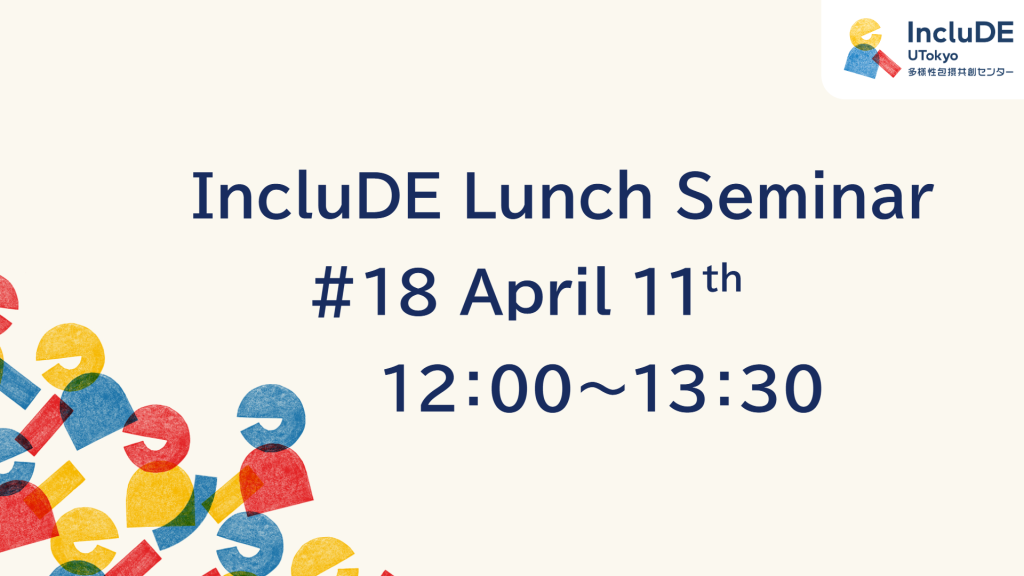(KUMAGAYA Shinichiro)
Purpose and Outline of the Symposium
The concept of “neurodiversity,” spawned by several autistic people in the online communities that have emerged since the 1990s, is gradually becoming known in Japan. The concept was born in the context of self-advocacy, criticizing a paradigm that forced unidirectional adaptation to a society designed for the neurotypical.
In recent years, however, the term has been used more and more as an expression of human resources. The perspective of human rights, which was the background of the term, has tended to recede into the background.
Based on this awareness of these issues, the International Symposium “The Origin and Development of Neurodiversity” was held on September 16, 2024 (Monday) from 14:00 to 18:00 as a hybrid symposium jointly hosted by the University of Tokyo’s Research Center for Advanced Science and Technology and the Center for Coproduction of Inclusion, Diversity and Equity.
On the day, simultaneous interpretation in English and Korean was provided in addition to Japanese (with Japanese Sign Language and Communication Access Realtime Translation). In addition, a quiet room was set up and an announcement was made at the beginning of the meeting that clapping should be done in the same hand flapping style as in the Deaf community, which is often adopted in other countries as a consideration for participants with hyperacusis.
A view of the venue. The screen in the foreground shows the slide presentation and Communication Access Realtime Translation (CART). To the left, from the audience’s perspective, is a Japanese Sign Language (JSL) interpreter and subtitles in the original language. Visitors were provided with simultaneous interpretation receivers that allowed them to choose between Japanese, English, and Korean.
The reception desk. A transparent screen displays text generated by automated speech recognition.
A total of 244 people attended the symposium, including 54 in-person participants and 190 online participants on the day of the event. These included 126 neurodivergent people, 64 educators, 8 government officials, 27 businesspeople, 56 researchers, 47 medical professionals, and 51 supporters.
The symposium was divided into three parts. In the first part, practitioners of the neurodiversity movement and participatory autism research/tojisha-kenkyu of autism from Finland, the United Kingdom, South Korea, Chile, and Japan were invited to give an overview of the background of the term “neurodiversity” and the subsequent development of the movement and research.
In the second part, the speakers introduced how the concept of neurodiversity is accepted and practiced in various fields in Japan, such as welfare, architecture, urban planning, education, business, and medical care.
Based on these presentations, the third part of the seminar consisted of a general discussion on issues that should be addressed in the future.
The following is a detailed report of this event.
Opening Remarks
The opening address was given by KASAI Kiyoto, Professor from Graduate School of Medicine, the University of Tokyo.
As a researcher who has studied schizophrenia and at the same time a psychiatrist involved in clinical practice, KASAI explained that recent studies have revealed how society designed to accommodate the neurological majority and the stigma against the neurological minority that prevails there cause their suffering. He emphasized the importance of taking into account the social model of disability in the field of psychiatry as well, such as the idea of neurodiversity that there is no pecking order of good and bad in neurological diversity, and that minority disadvantage is caused by interaction with a society designed for the majority. He explained it is a very accurate description of reality based on the collective history of the neurodivergent people.
He also reviewed the history of words such as “independence,” “recovery,” and “neurodiversity,” which were created by the minority in the midst of their traumatic historical circumstances, but have been decontextualized and their meanings transformed to conform to the values of the majority. He strongly explained the purpose of the symposium, saying that work such as this symposium, which traces the history of the term “neurodiversity”, is indispensable to prevent co-production from becoming a tokenism.
KASAI Kiyoto
Part I
In the first part of the meeting that followed, five activists and researchers in the field of autism took the stage and gave an insight into some autistic people’s activities that have spread internationally since the 1990s.
Martijn DEKKER from the Netherlands founded Independent Living on the Autistic Spectrum (InLv) in the 1990s, one of the first global online communities for autistic people. It was there that the concept of neurodiversity was born. He also served for many years as chair and is currently vice chair of the UK Autscape Organisation, which organizes the annual Autscape, an in-person autistic space.
In a society where communication styles designed for neurotypical people are prevalent, DEKKER’s presentation pointed out that the term “neurodiversity” was born from such online and offline autistic spaces, and that in such spaces, empathy and mutual help between the autistic people can occur, and as a result, they are breaking down the unflattering stereotype of autism that has been described by professionals as a disorder of communication and empathy.
In addition, DEKKER’s comment that “productivity should serve people, not the other way around” raised a very important issue for the Japanese discourse, where neurodiversity is often associated with economic rationality rather than human rights.
Martijn DEKKER
Heta PUKKI, after receiving a master’s degree in biology from the University of Helsinki and a master’s degree in education from the University of Birmingham, specializes in working with adults with autism with a focus on empowerment. As the project coordinator of the Erasmus+ project “Digital for All”, promoting digital skills education for people with disabilities, the president of the NGO Autistic Spectrum Finland, and the president of the European Council of Autistic People (EUCAP), she advocates for the rights of autistic people throughout Europe. She also leads the Global Autistic Task Force on Autism Research (GATFAR), an international network that makes recommendations on autism research from the perspective of autistic individuals.
PUKKI explained that even among autistic people, there are different interpretations of the terms “disability” and “neurodiversity,” and that EUCAP has created a constitution that is acceptable to all through a year and a half of persistent dialogue among groups of autistic people from 17 European countries, aiming for solidarity rather than division. She also explained that in order to prevent the co-production of autism research from becoming a mere formality, it is important for the research community to collaborate not only with disparate autistic individuals, but also with communities of autistic people who share values, language, and history. We learned that GATFAR was founded with such a community in mind.
The practices of these two groups gave us insights into the democratic procedures that are essential for the realization and co-production of DEIs.
Heta PUKKI
AYAYA Satsuki is a specially appointed associate professor at the University of Tokyo’s Research Center for Advanced Science and Technology (RCAST) and founded “Otoemojite”, a research group for and by neurodivergent people in 2011. Her research focuses on the interaction between autistic people and the neuromajority.
AYAYA shared her vision that the combination of Tojisha-Kenkyu, a participatory research that has developed uniquely in Japan, and the co-production of autism research, which is actively developing in Japan, will correct the epistemic injustice surrounding autism, and that both wheels will contribute to both social inclusion and autism research, with a wealth of examples.
AYAYA Satsuki
YOON Wn-ho is a Senior Research Fellow at the Institute of Japanese Studies, Incheon National University, where he has worked on Japanese culture, particularly anime, web fiction, otaku culture, and content tourism. He has also been a visiting professor at Incheon National University from 2019-2022, teaching cultural content and media studies, as well as working as a journalist.
He introduced the Korean self-advocacy movement and policy actions by the Autistic, and pointed out the importance of cultural studies on the value of Japanese web culture, manga, and cosplay-related events as autistic spaces, as well as approaches from psychiatry and pedagogy. He also offered a vision of solidarity among autistic people in Korea and Japan.
YOON Wn-ho
Francisco PIZARRO Olivares is a clinical neuropsychologist specializing in neuropsychological assessment of adults and the elderly, and is a lecturer and academic coordinator at the Catholic University of Chile (CEDETi UC) and Diego Portales University (CENHN UDP). He is also one of the founding members of the Chilean Society of Clinical Neuropsychology.
PIZARRO spoke about the activism among Chilean students that began with the Penguin Revolution initiated by high school students in 2006 and culminated in the drafting of a new constitution in the 2020s, which included the “rights of neurodiverse persons” in Article 19, but was narrowly rejected, and how this movement led to the passage of the “autism spectrum law” in 2023. He also looked forward to the possibilities of collaboration between neuropsychology and Tojisha-Kenkyu on autism.
Mr. Francisco PIZARRO Olivares
Part II
In the second part, 5 speakers from Japan introduced the current situation and challenges of people with developmental disabilities in Japan and the impact that the concept of neurodiversity is having.
HIZUME Masafumi is a speech-language pathologist, Vice President and Executive Director of the Japan Developmental Disabilities Network, and Director of Research at Nozominosono, a national comprehensive facility for people with severe intellectual disabilities. Having served as an expert on developmental disabilities at the Ministry of Health, Labour and Welfare, he is well versed in the field of developmental disabilities support and policy in Japan, including its historical evolution.
Along with institutional history and epidemiological data, HIZUME introduced the current situation of elderly people with developmental disabilities who have difficulty self-identifying as disabled, inclusive evacuation planning in the event of natural disasters, the establishment of calming rooms in public facilities, and efforts to seek inclusive COVID-19 measures and medical care.
HIZUME Masafumi
NIWA Nao is a first-class architect and doctor of engineering, and runs BASSTRONAUTICS ADMINISTRATION, a design office for barrier-free housing, as well as conducting research on universal design and inclusive design as an associate professor at Chuo University. From 2022,in cooperation with Japan Airlines and Haneda Airport, she has been conducting boarding experiences for people with disabilities who are not easily noticed.
NIWA introduced initiatives aimed at the inclusion of people with sensory diversity in cities around the world, such as Quiet Hour and Sensory Map, as well as universal design initiatives for airports and aircraft, including research at Haneda Airport in collaboration with AYAYA.
NIWA Nao
As a researcher in the Research Office of the Committee on Education, Culture and Science of the House of Councilors, TAKEUCHI Kenta has been working toward the realization of inclusive education in particular from a legislative standpoint, and has published articles on the current status and challenges of special-needs education and the status of special-needs education in Japan for the realization of inclusive education.
After mentioning that the House of Councillors is becoming more accessible due to the presence of members with severe disabilities, TAKEUCHI gave a convincing data-based understanding and analysis of the current situation regarding Japan’s structural problems of segregation policy in primary and secondary education and insufficient consideration in regular classes, which were pointed out by the United Nations, and teacher shortage.
YASUI Naoko, Group Leader of DE&I Group, Human Resources Department, Mitsui Chemicals, Inc.
She explained that open position recruitment and incubation periods, which do not limit job duties, enabled matching without stereotyping by disability type, such as savantism. She reported that most of neurodivergent employees had been able to transition to permanent employment by sharing and responding to problems, improving the environment, and conducting fair evaluations through the use of journals and internal and external consultation and support.
YASUI Naoko
UCHIYAMA Tokio is a child psychiatrist, CEO of Yokohama Developmental Group, Vice President of Fukushima Gakuin University, and Director of Parents and Children Support Center Fukushima.
Based on a comparison of the acceptance of the concept of neurodiversity in Japanese and British ministries, UCHIYAMA pointed out that in Japan the term is mainly used by the Ministry of Economy, Trade and Industry, while in the UK the term is referenced by the Ministry of Justice, Ministry of Transport, Ministry of Health and Welfare, and Ministry of Education. As DEKKER pointed out, in Japan, the term tends to be used in a paradigm that regards people as instrumental human resources for the purpose of improving productivity.
UCHIYAMA Tokio
Part III
In the third part, a panel discussion was held.
First, KUMAGAYA Shinichiro from the Research Center for Advanced Science and Technology at the University of Tokyo briefly reviewed the speeches of each speaker, dividing them into five themes: “autospace and autistic epistemic community,” “productivity as a means and human rights model,” “democratic process,” “co-production,” and “Japanese reality,” which was followed by a discussion among the symposium participants.
In particular, the panelists touched on the fact that in the history of gender equality, women proposed the motto “women’s success, not women’s utilization,” and their comments that the same situation must be kept in mind in neurodiversity now seemed to be very important.
Panel Discussion
During the discussion with the floor, there was a discussion about how to lobby for legislation to change society and how narratives about neurodiversity can redress hermeneutical injustice and scientific research can redress testimonial injustice, in that narratives and science are complementary approaches to redressing epistemic injustice.
Closing Remarks
ITO Takane, Director of the Center for Coproduction of Inclusion, Diversity and Equity at the University of Tokyo, gave closing remarks.
ITO spoke about the increasing importance of neurodiversity to the Center, which was just established in April of this year with the aim of realizing a campus and society that is inclusive of its diverse constituents in terms of gender, SOGI, disabilities, etc., under the slogan “Nothing about us, without us!” She noted that, although recognized as increasingly important, Japan is still dominated by discourses originating from the perspective of neurotypical supporters and family members, rather than neurodivergent people, and the collective “voices” of the neurodivergent people, which should guide the Center, had not been adequately heard.
She also stated that what is important is the international solidarity of the neurominorities and concrete actions such as co-production of policies, services, research, etc. that will start from here, and expressed her solidarity for the realization of a society that is inclusive of neurodiversity.
ITO Takane
Editorial note
Neurodiversity, whose historical context of about 30 years has been forgotten, is now being populated while being given a distorted semantic content. It was of great significance that we were able to invite autistic people who have been involved in the history of the birth and spread of the concept to hear their voices at this juncture.
As ITO pointed out, in Japan, laws and policies tend to reflect the voices of supporters and family members rather than those of the neurodivergent people. Even in self-advocacy initiatives, there are many practices in which neurotypical supporters encourage neurodivergent people to practice self-advocacy. To change this status quo, it will be necessary for the neurodivergent community, which expresses the unique experiences and needs of minorities, to play a leading role in change, which is essential to correcting epistemic injustices.
We hope that this symposium will be a catalyst for international collaboration among people involved in the field of neurodiversity, and that the circle of allies will expand among academia, business, legislation, and government.







